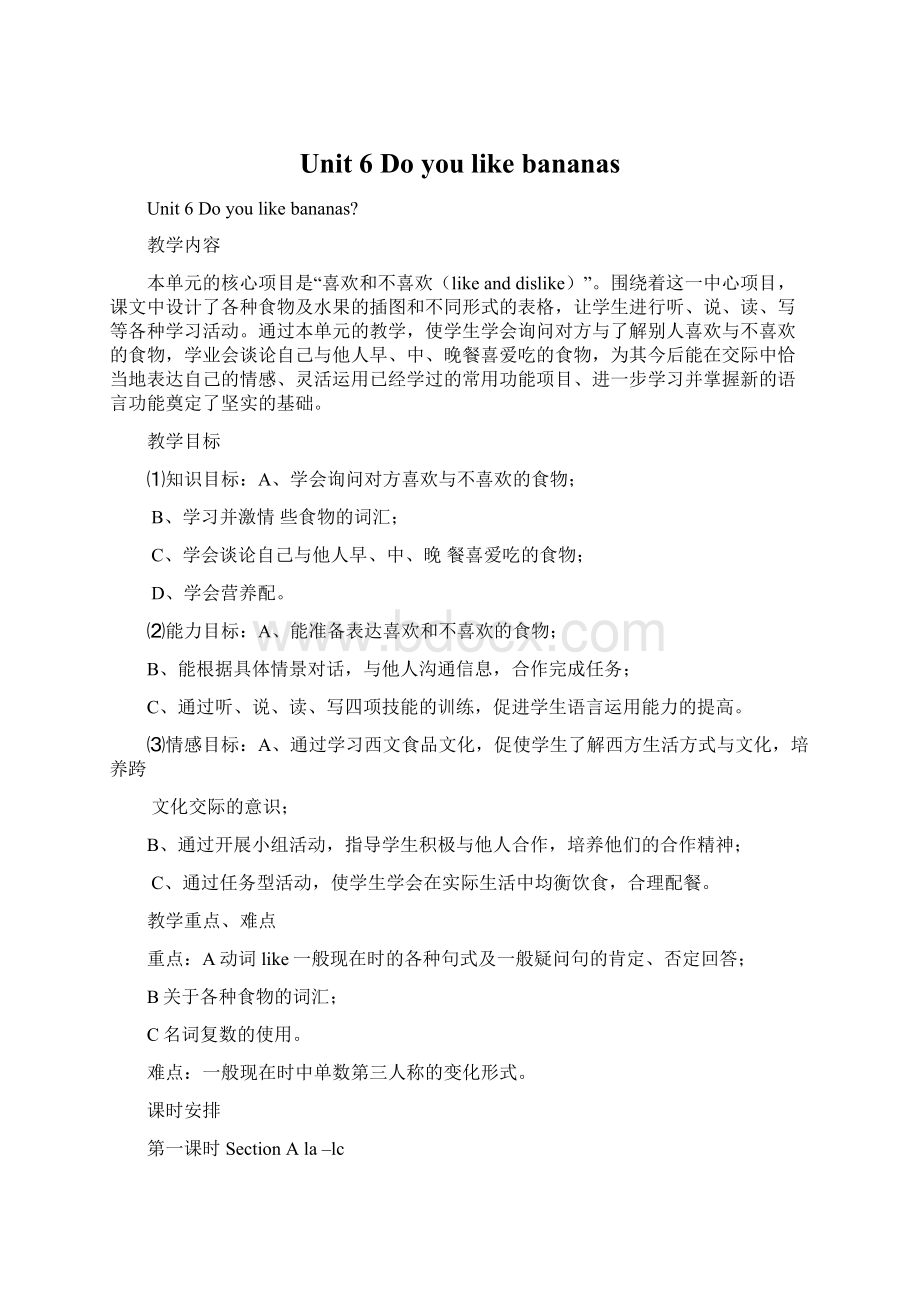Unit 6 Do you like bananas.docx
《Unit 6 Do you like bananas.docx》由会员分享,可在线阅读,更多相关《Unit 6 Do you like bananas.docx(13页珍藏版)》请在冰豆网上搜索。

Unit6Doyoulikebananas
Unit6Doyoulikebananas?
教学内容
本单元的核心项目是“喜欢和不喜欢(likeanddislike)”。
围绕着这一中心项目,课文中设计了各种食物及水果的插图和不同形式的表格,让学生进行听、说、读、写等各种学习活动。
通过本单元的教学,使学生学会询问对方与了解别人喜欢与不喜欢的食物,学业会谈论自己与他人早、中、晚餐喜爱吃的食物,为其今后能在交际中恰当地表达自己的情感、灵活运用已经学过的常用功能项目、进一步学习并掌握新的语言功能奠定了坚实的基础。
教学目标
⑴知识目标:
A、学会询问对方喜欢与不喜欢的食物;
B、学习并激情些食物的词汇;
C、学会谈论自己与他人早、中、晚餐喜爱吃的食物;
D、学会营养配。
⑵能力目标:
A、能准备表达喜欢和不喜欢的食物;
B、能根据具体情景对话,与他人沟通信息,合作完成任务;
C、通过听、说、读、写四项技能的训练,促进学生语言运用能力的提高。
⑶情感目标:
A、通过学习西文食品文化,促使学生了解西方生活方式与文化,培养跨
文化交际的意识;
B、通过开展小组活动,指导学生积极与他人合作,培养他们的合作精神;
C、通过任务型活动,使学生学会在实际生活中均衡饮食,合理配餐。
教学重点、难点
重点:
A动词like一般现在时的各种句式及一般疑问句的肯定、否定回答;
B关于各种食物的词汇;
C名词复数的使用。
难点:
一般现在时中单数第三人称的变化形式。
课时安排
第一课时SectionAla–lc
第二课时SectionA2a–4
第三课时SectionBla–2c
第四课时SectionB3a–4Self-check
PeriodOne
课前准备
教师:
搜集关于食物的图片,多媒体教学课件,制作表格(见教学步骤)。
教学设计
StepOne:
Newwords.
1Presentthenewwords.
T:
Let’splayaguessinggame.Isitanappleinmybag?
Touchandtellmetheanswer.
S1:
(Touchandsay)Yes,it’sanorange.
T:
Ilikeoranges.Likemeans”喜欢”.Readafterme.L-I-K-E,like.
Ss:
L-I-K-E,like.
T:
Doyoulikeoranges?
S2:
Yes,Ido.
T:
Doyoulikeoranges?
S3:
No,Idon’t.
(Teacherwritesthetitleontheblackboard.)
T:
NowtodayIhavealotofdeliciousfood.Firstlet’slookatsomefruit.Look!
(Showapictureofabanana.)
T:
What’sthisinEnglish?
It’sabanana.Readafterme,B-A-N-A-N-A,banana.
Ss:
B-A-N-A-N-A,banana.
T:
Whatcolorisit?
Ss:
It’syellow.
(Thenlookatsomepicturesandteachtheotherfruitwordsinthesamewaysuchasstrawberry,apple.)
(Nextgoonlearningthevegetablesandtheotherfoodinthesamewaywiththepictures.)
T:
Lookatthepicturesandfillinthechataccordingtothecategory.
Fruit
Food
Vegetable
StepTwo:
Grammar.
1Presentthecountablenounsandtheuncountablenouns.
T:
Look!
Whatarethese?
(Showapicture.)
S1:
Theyareoranges.
T:
Howmanyorangesarethere?
Let’scount.One,two.
S1:
Two.
T:
Andwhatarethese?
(Showanotherpicture.)
S2:
areapples.
T:
Howmanyapplesarethere?
Let’scountthem.One,two,three.
S2:
Three.
T:
What’sthis?
S3:
It’sbroccoli.
T:
Canwecountit”Canwesayabroccoli?
”
S3:
Sorry,Idon’tknow.
T:
Wecan’tsayabroccolibecauseitistheuncountablenoun.Nounscontainthecountablenounsandtheuncountablenouns.Countablenounscanbecountedwithnumber,andweadd–sor–estomaketheplural.Forexample,wecansayanapple,twoapples,threeeggs.Uncountablenounscan’tbecountedwithnumber,buttheydon’thaveplurals.Forexample,wecansaysalad,broccoli,butwecan’tsaysalads,broccolis.
T:
Lookatthepictures.Fillinthechart.(Showsomepicturesoffruitsandvegetables.)
Countblenouns
Uncountablenouns
T:
Checktheanswers.
2Presenttherulesofnounpluralforms.
T:
Lookatthepictures,canyousaythem?
S:
Yes,threetomatoes,twooranges,threestrawberries.
T:
Lookatthethreerulesofpluralforms.Aretheythesame?
S:
Ofcoursenot.
StepThree:
Drills.
1Presentthenewdrills“Doyoulike…?
Yes,Ido/No,Idon’t.”
T:
Oh,wehavelotsofdeliciousfruit.Ilikeapplesbest.
(Holdingapples)
Doyoulikethem?
S1:
Yes,Ido.
S2:
No,Idon’t.Ilikesalad.
T:
Doyoulikesalad?
S3:
Yes,Ido./No,Idon’t.
(Asksomemorestudentstopracticelikethis.)
2Practicethedrill.
T:
Workinpairs.Askandanswerwithyourpictures.
(Beforeclassthestudentshavedrawnsomepicturesofthefood.)
Sa:
Doyoulike…?
Sb:
…
(Thenaskmorepairstopractice.)
T:
Let’sopenyourbooksanddo1b.Listenandnumber1-3.
(Thestudentslistenandthenchecktheanswers.)
StepFour:
Task.
T:
Let’smakeasurvey.Youcanaskeightfriendswhattheylikeanddislike.Thenfillinthechart.
Tom
Kate
LiLei
…
Apples
Bananas
…
(Thenasksomestudentstoreport.)
S1:
Fiveofthestudentslike…,twoofthemlike…
S2:
…
StepFive:
Summary.
Inthisclass,we’velearntthenamesoffoods,fruitandvegetablesandpracticedaskingandansweringquestionsaboutlikesanddislikes.Pleaseremembertherulesofnounplurals.
Homework.
Makeasurveyaboutyourparent’slikesanddislikesusingDoyoulike…?
PeriodTwo
课前准备
教师:
搜集关于食物的图片,制作表格(见教学步骤)。
学生:
准备上一节课的调查表格,作好对话和调查的准备。
教学设计
StepOne:
Reviewthedrill.
2Reviewthedrill“Doyoulike…”?
3Thegirlandtheboyaretalkingabouttheirlikesanddislike.Let’sopenyourbooksandlisten.Trytofinish2aand2basquicklyasyoucan.
Ss:
…
StepTwo:
Newdrills.
1Presentthenewdrills“Doesshe/helike…?
Yes,she/hedoes./No,she/hedoesn’tusethechartabove.
T:
Kate,doyouliketomatoes?
S1:
Yes,Ido.
T:
Doyoulikeicecream?
S1:
No,Idon’t.
(TheteacherpointsatKateandaskstheclass.)
T:
DoesKateliketomatoes?
Ss:
Yes,shedoes.
T:
DoesKatelikeicecream?
Ss:
No,shedoesn’t.
(TheteachergoesonaskingKateusingthechart.)
T:
DoesyourbestfriendSueliketomatoes?
S1:
Yes,shedoes.(Katelooksatherchartinherhand.)
T:
Whoisyourbestfriend?
(TheteacherpointsatJane.)
S1:
Sallyis.
T:
Doessheliketomatoes?
S1:
Sallyis.
(TheteacherpointsatTonyandMaria.)
T:
Doyourbestfriendsliketomatoes?
S1:
Yes,theydo./No,theydon’t.
(Theteacheraskstwomorestudentstoanswerhis/herquestionsaccordingtothechartintheirhands.Thentheteacherwritesdownthedrills“Doesshe/helike…?
Dotheylike…?
”ontheblackboard.)
T:
Workinpairsandpracticethedrill“Doeshe/she…?
Dothey…?
”accordingtothechart.
(Thentheteacheraskssomepairsofthestudentstopracticeonebyone.)
2Practicethedrills.
T:
Let’sworkinpairs.
(StudentAlooksatPage33.StudentBlooksatPage83.TrytofindoutwhatBobandBillanddon’tlike.)
Sa:
DoesBilllikeFrenchfries?
Sb:
…DoesBoblikeFrenchfries?
Sa:
…
StepThree:
Task.
T:
Doyouloveyourparents?
S:
Yes.
T:
Howdoyoushowyourlovetothem?
S1:
I’lldoastheysay.
S2:
I’llbuysomethingforthemwhentheirbirthdayiscoming.
S3:
I’llstudybetterandbetter.
S4:
I’llmakeabigmealforthem.
T:
Oh,Ithinkit’sagoodidea.Nowlet’strytoknowwhattheylikeanddislike.Firsttakeoutyesterday’shomework,exchangetheinformationinpairs.
(Theteacherhasaskedthestudentstohaveasurveylastclass.)
Parents
like
dislike
Mother
Father
(Giveasampletothestudents)
T:
Doesyourfatherlikechicken?
(Pointtoastudent)
S1:
No,hedoesn’t.
T:
Doesyourmotherlikeeggs?
S1:
Yes,shedoes.
T:
Dotheylikebananas?
S1:
Yes,theydo.
T:
Nowworkingroupsandmakeafoodsurvey.
Parents
like
dislike
Jim’sfather
Jim’smother
Kate’sfather
Kate’smother
(Thestudentsworkingroups.)
S2:
Jim’sfatherlikes…Hedoesn’tlike…Jim’smotherlikes…verymuch.Shedoesn’tlike…Andtheybothdon’tlike…
(Thenaskmorestudentstoreport.)
StepFour:
Summary.
Inthisclass,we’velearnttheSimplePresentTense,includingofthethirdpersonsingularformassubject.
Homework.
Rewriteyourconversationintheformofapassage.
PeriodThree
课前准备
教师:
搜集关于食物的图片,多媒体教学课件,制作表格(见教学步骤)。
学生:
准备上一节课的家庭作业。
教学设计
StepOne:
Checkthehomework.
T:
Nowlet’scxchangeyourexercisebooksandhelpeachother.Trytocorrectit.(Askdifferentstudentstoreporthis/herconversation.)
StepTwp:
Reviewthewords.
T:
Youknowwehavelearntsomuchdeliciousfood.NowLet’splayagamewiththefood.Let’sseewhowillsaythenamesofthefoodasmanyaspossibleduringaminute.
(Theteacherwillgivethestudentsaminutetoprepareit.Thenasksomeonetosay.)
S:
Salad,apples,bananas,icecream…
(Choosethethreestudentswhosaidthemostandgivesomefoodaspresents.)
StepThree:
Newwords.
1Presentthenewwords.
T:
Howmanymealsdoyouhaveeveryday?
Ss:
Three.
T:
Whatarethey?
(ThestudentscananswertheminChinese.)
Ss:
Theyare“早餐、中餐和晚餐”.
T:
Oh,yes.InEnglish“早餐”wecansay“breakfast”.
(Showapictureofthebreakfast)
Readafterme,“breakfast”.
B-R-E-A-K-F-A-S-T,breakfast.
Ss:
B-R-E-A-K-F-A-S-T,breakfast.
T:
Doyouhaveyourbreakfasteveryday?
S1:
No,sometimesIgetuplate,Ihavenotimetoeat.
T:
Ithinkit’snotgoodforyourhealth.
(Teachtheothertwowordslunch,dinnerinthesameway.)
2Practicethewords.
T:
Whichmealdoyoulikebest?
(Pointtoastudent.)
S:
Ilikebreakfastbest.
T:
Why?
S:
BecauseIlikedrinkingmilk.
T:
Whoalsolikesbreakfastinourclass?
Pleaseputupyourhands.
T:
Oh,somanystudents.Youcansitinthisteam.
(Askallthestudentswholikebreakfast,lunchordinnertocometothesameteam.Theycantalkeasily.)
T:
Wehavedividedalltheclassintothreegroups.Onegrouplikesbreakfast,theothertwolikelunchanddinner.Butwhatdoyoulikeforyourthreemeals?
(Showapictureofthreedinners.)
T:
Ihavethreemealplates.Whatdoyouwanttoputonit?
Let’stalkaboutit.Trytofindthefoodwhatyourgrouplikemostandtellusthereason.
(Wheneachgroupistalkingaboutit,theteachergoesaroundamongthestudentsandhelpsthemiftheyneed.Thenaskeachgrouptoreport.)
S:
Inourgroup,welikebreakfastbest.Wealllikeoranges,eggs,milkandanapple.Becausetheyaregoodforourhealth,wechoosethem.
(Whenthestudentissaying,theteacherputsthefoodontotheplateforbreakfast.)
(Doitforlunchanddinnerinthesameway.)
T:
Lookat1a,andwritethenumberintheboxnexttothecorrectfood.
(Thenthestudentsfinishoff1a.)
T:
Howmanyotherfoodwordscanyouaddtothechart?
Trytowritethemdowninthechart.
Fruits:
Vegetables:
(Thestudentswritethemdownassoonaspossibleandthenreadthem.Seewhowilladdmost.)
StepFour:
Practicethelistening.
T:
Look!
There